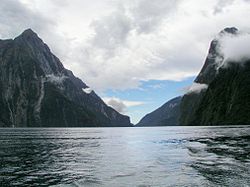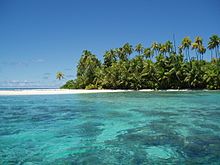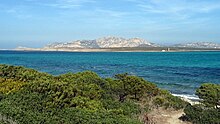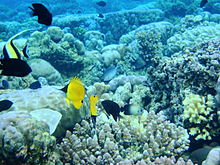
A | B | C | D | E | F | G | H | CH | I | J | K | L | M | N | O | P | Q | R | S | T | U | V | W | X | Y | Z | 0 | 1 | 2 | 3 | 4 | 5 | 6 | 7 | 8 | 9

Marine protected areas (MPAs) are protected areas of the world's seas, oceans, estuaries or in the US, the Great Lakes.[2] These marine areas can come in many forms ranging from wildlife refuges to research facilities.[3] MPAs restrict human activity for a conservation purpose, typically to protect natural or cultural resources.[4] Such marine resources are protected by local, state, territorial, native, regional, national, or international authorities and differ substantially among and between nations. This variation includes different limitations on development, fishing practices, fishing seasons and catch limits, moorings and bans on removing or disrupting marine life. In some situations (such as with the Phoenix Islands Protected Area), MPAs also provide revenue for countries, potentially equal to the income that they would have if they were to grant companies permissions to fish.[5] The value of MPA to mobile species is unknown.[6]
There are a number of global examples of large marine conservation areas. The Papahānaumokuākea Marine National Monument, is situated in the central Pacific Ocean, around Hawaii, occupying an area of 1.5 million square kilometers.[7] The area is rich in wild life, including the green turtle and the Hawaiian monkfish, alongside 7,000 other species, and 14 million seabirds.[8] In 2017 the Cook Islands passed the Marae Moana Act designating the whole of the country's marine exclusive economic zone, which has an area of 1.9 million square kilometers as a zone with the purpose of protecting and conserving the "ecological, biodiversity and heritage values of the Cook Islands marine environment".[9]: 355 Other large marine conservation areas include those around Antarctica, New Caledonia, Greenland, Alaska, Ascension Island, and Brazil.
As areas of protected marine biodiversity expand, there has been an increase in ocean science funding, essential for preserving marine resources.[10] In 2020, only around 7.5 to 8% of the global ocean area falls under a conservation designation.[11] This area is equivalent to 27 million square kilometres, equivalent to the land areas of Russia and Canada combined, although some argue that the effective conservation zones (ones with the strictest regulations) occupy only 5% of the ocean area (about equivalent to the land area of Russia alone). Marine conservation zones, as with their terrestrial equivalents, vary in terms of rules and regulations. Few zones rule out completely any sort of human activity within their area, as activities such as fishing, tourism, and transport of essential goods and services by ship, are part of the fabric of nation states.
Terminology

The International Union for Conservation of Nature (IUCN) defines a protected area as:[12][13]
A clearly defined geographical space, recognised, dedicated and managed, through legal or other effective means, to achieve the long-term conservation of nature with associated ecosystem services and cultural values.
This definition is intended to make it more difficult to claim MPA status for regions where exploitation of marine resources occurs. If there is no defined long-term goal for conservation and ecological recovery and extraction of marine resources occurs, a region is not a marine protected area.[13]
"Marine protected area (MPA)" is a term for protected areas that include marine environment and biodiversity.
Other definitions by the IUCN include (2010):[14]
Any area of the intertidal or subtidal terrain, together with its overlying water and associated flora, fauna, historical and cultural features, which has been reserved by law or other effective means to protect part or all of the enclosed environment.
United States Executive Order 13158 in May 2000 established MPAs, defining them as:[15]
Any area of the marine environment that has been reserved by federal, state, tribal, territorial, or local laws or regulations to provide lasting protection for part or all of the natural and cultural resources therein.
The Convention on Biological Diversity defined the broader term of marine and coastal protected area (MCPA):[16]
Any defined area within or adjacent to the marine environment, together with its overlying water and associated flora, fauna, historical and cultural features, which has been reserved by legislation or other effective means, including custom, with the effect that its marine and/or coastal biodiversity enjoys a higher level of protection than its surroundings.
An apparently unique extension of the meaning is used by NOAA to refer to protected areas on the Great Lakes of North America.[2]
History
The form of marine protected areas trace the origins to the World Congress on National Parks in 1962. In 1976, a process was delivered to the excessive rights to every sovereign state to establish marine protected areas at over 200 nautical miles.
Over the next two decades, a scientific body of evidence marked the utility in the designation of marine protected areas. In the aftermath of the 1992 Earth Summit in Rio de Janeiro, an international target was established with the encompassment of ten percent of the world's marine protected areas.
On 28 October 2016 in Hobart, Australia, the Convention for the Conservation of Antarctic Marine Living Resources agreed to establish the first Antarctic and largest marine protected area in the world encompassing 1.55 million km2 (600,000 sq mi) in the Ross Sea.[17] Other large MPAs are in the Indian, Pacific, and Atlantic Oceans, in certain exclusive economic zones of Australia and overseas territories of France, the United Kingdom and the United States, with major (990,000 square kilometres (380,000 sq mi) or larger) new or expanded MPAs by these nations since 2012—such as Natural Park of the Coral Sea, Pacific Remote Islands Marine National Monument, Coral Sea Commonwealth Marine Reserve and South Georgia and the South Sandwich Islands Marine Protected Area.
When counted with MPAs of all sizes from many other countries, as of April 2023 there are more than 16,615 MPAs, encompassing 7.2% of the world's oceans (26,146,645 km2), with less than half of that area – encompassing 2.9% of the world's oceans – assessed to be fully or highly protected according to the MPA Guide Framework.[18]
Classifications

Several types of compliant MPA can be distinguished:
- A totally marine area with no significant terrestrial parts.
- An area containing both marine and terrestrial components, which can vary between two extremes; those that are predominantly maritime with little land (for example, an atoll would have a tiny island with a significant maritime population surrounding it), or that is mostly terrestrial.
- Marine ecosystems that contain land and intertidal components only. For example, a mangrove forest would contain no open sea or ocean marine environment, but its river-like marine ecosystem nevertheless complies with the definition.
IUCN offered seven categories of protected area, based on management objectives and four broad governance types.
| Cat | IUCN Protected Area Management Categories: |
|---|---|
Ia
|
Strict nature reserve A marine reserve usually connotes "maximum protection", where all resource removals are strictly prohibited. In countries such as Kenya and Belize, marine reserves allow for low-risk removals to sustain local communities. |
Ib
|
Wilderness area |
II
|
National park Marine parks emphasize the protection of ecosystems but allow light human use. A marine park may prohibit fishing or extraction of resources, but allow recreation. Some marine parks, such as those in Tanzania, are zoned and allow activities such as fishing only in low risk areas. |
III
|
Natural monuments or features Established to protect historical sites such as shipwrecks and cultural sites such as aboriginal fishing grounds. |
IV
|
Habitat/species management area Established to protect a certain species, to benefit fisheries, rare habitat, as spawning/nursing grounds for fish, or to protect entire ecosystems. |
V
|
Protected seascape Limited active management, as with protected landscapes. |
VI
|
Sustainable use of natural resources |
Related protected area categories include the following;
- World Heritage Site (WHS) – an area exhibiting extensive natural or cultural history. Maritime areas are poorly represented, however, with only 46 out of over 800 sites.
- Man and the Biosphere – UNESCO program that promotes "a balanced relationship between humans and the biosphere". Under article 4, biosphere reserves must "encompass a mosaic of ecological systems", and thus combine terrestrial, coastal, or marine ecosystems. In structure they are similar to Multiple-use MPAs, with a core area ringed by different degrees of protection.[20]
- Ramsar site – must meet certain criteria for the definition of "Wetland" to become part of a global system. These sites do not necessarily receive protection, but are indexed by importance for later recommendation to an agency that could designate it a protected area.[21]
While "area" refers to a single contiguous location, terms such as "network", "system", and "region" that group MPAs are not always consistently employed."System" is more often used to refer to an individual MPA, whereas "region" is defined by the World Conservation Monitoring Centre as:[22]
A collection of individual MPAs operating cooperatively, at various spatial scales and with a range of protection levels that are designed to meet objectives that a single reserve cannot achieve.
At the 2004 Convention on Biological Diversity, the agency agreed to use "network" on a global level, while adopting system for national and regional levels. The network is a mechanism to establish regional and local systems, but carries no authority or mandate, leaving all activity within the "system".[23]

No take zones (NTZs), are areas designated in a number of the world's MPAs, where all forms of exploitation are prohibited and severely limits human activities. These no take zones can cover an entire MPA, or specific portions. For example, the 1,150,000 square kilometres (440,000 sq mi) Papahānaumokuākea Marine National Monument, the world's largest MPA (and largest protected area of any type, land or sea), is a 100% no take zone.[24]
Related terms include; specially protected area (SPA), Special Area of Conservation (SAC), the United Kingdom's marine conservation zones (MCZs),[25] or area of special conservation (ASC) etc. which each provide specific restrictions.
Stressors
Stressors that affect oceans include the impact of extractive industries, marine pollution, and changes to the ocean's chemistry (ocean acidification) resulting from elevated carbon dioxide levels, due to our greenhouse gas emissions (see also effects of climate change on oceans).[26]
MPAs have been cited as the ocean's single greatest hope for increasing the resilience of the marine environment to such stressors.[26] Well-designed and managed MPAs developed with input and support from interested stakeholders can conserve biodiversity and protect and restore fisheries.
Economics
MPAs can help sustain local economies by supporting fisheries and tourism. For example, Apo Island in the Philippines made protected one quarter of their reef, allowing fish to recover, jump-starting their economy. This was shown in the film, Resources at Risk: Philippine Coral Reef.[27] A 2016 report by the Center for Development and Strategy found that programs like the United States National Marine Sanctuary system can develop considerable economic benefits for communities through Public–private partnerships.[28] They can be self-financed through a surrounding "conservation finance area" in which a limited number licenses are granted to benefit from the spillover of the marine protected area.[29]
Management
Typical MPAs restrict fishing, oil and gas mining and/or tourism. Other restrictions may limit the use of ultrasonic devices like sonar (which may confuse the guidance system of cetaceans), development, construction and the like. Some fishing restrictions include "no-take" zones, which means that no fishing is allowed. Less than 1% of US MPAs are no-take.
Ship transit can also be restricted or banned, either as a preventive measure or to avoid direct disturbance to individual species. The degree to which environmental regulations affect shipping varies according to whether MPAs are located in territorial waters, exclusive economic zones, or the high seas. The law of the sea regulates these limits.
Most MPAs have been located in territorial waters, where the appropriate government can enforce them. However, MPAs have been established in exclusive economic zones and in international waters. For example, Italy, France and Monaco in 1999 jointly established a cetacean sanctuary in the Ligurian Sea named the Pelagos Sanctuary for Mediterranean Marine Mammals. This sanctuary includes both national and international waters. Both the CBD and IUCN recommended a variety of management systems for use in a protected area system. They advocated that MPAs be seen as one of many "nodes" in a network of protected areas.[30] The following are the most common management systems:

Seasonal and temporary management—Activities, most critically fishing, are restricted seasonally or temporarily, e.g., to protect spawning/nursing grounds or to let a rapidly reducing species recover.
Multiple-use MPAs—These are the most common and arguably the most effective. These areas employ two or more protections. The most important sections get the highest protection, such as a no take zone and are surrounded with areas of lesser protections. Multiple-use MPAs can make use of very diverse fisheries regulations to balance fisheries extraction with nature protection.[32]
Community involvement and related approaches—Community-managed MPAs empower local communities to operate partially or completely independent of the governmental jurisdictions they occupy. Empowering communities to manage resources can lower conflict levels and enlist the support of diverse groups that rely on the resource such as subsistence and commercial fishers, scientists, recreation, tourism businesses, youths and others. Mistrust between fishermen and regulating authorities is of central importance there, and needs to be addressed. Recent evidence from regions like Scandinavia, Spain, Portugal or Canada reveals success stories based on the tested cooperation between marine scientists and fishermen in jointly managing coastal marine reserves.[33]
Marine Protected Area Networks
Marine Protected Area Networks or MPA networks have been defined as "A group of MPAs that interact with one another ecologically and/or socially form a network".[27]
These networks are intended to connect individuals and MPAs and promote education and cooperation among various administrations and user groups. "MPA networks are, from the perspective of resource users, intended to address both environmental and socio-economic needs, complementary ecological and social goals and designs need greater research and policy support".[27]
Filipino communities connect with one another to share information about MPAs, creating a larger network through the social communities' support.[34] Emerging or established MPA networks can be found in Australia, Belize, the Red Sea, Gulf of Aden and Mexico.[27]
Future approaches
To be truly representative of the ocean and its range of marine resources, marine conservation parks should encompass the great variety of ocean geological and geographical terrains, as these, in turn, influence the biosphere around them.[citation needed] As time progresses it would be strategically advantageous to develop parks that include oceanic features such as ocean ridges, ocean trenches, island arc systems, ocean seamounts, ocean plateaus, and abyssal plains, which occupy half the earth's surface. Another factor that will influence the development of marine conservation areas is ownership. Who owns the world's oceans?[35] Approximately 64% of the world's oceans are "international waters" and subject to regulations such as the Law of the Sea and the governance of UN bodies such as the International Seabed Authority.[citation needed] The remaining 36% of the ocean is under the governance of individual countries within their Exclusive Economic Zones (EEZs).[citation needed] Some individual national EEZ's cover very large areas, such as France and USA (>11 million km2), and Australia, Russia, UK, and Indonesia (>6 million km2). Some states have very small land areas but extremely large EEZ's such as Kiribati, the Federated States of Micronesia, Marshall Islands, and Cook Islands who have individual EEZ areas of between 1.9 and 3.5 million km2. The national EEZ's are the ones where governance is easier, and agreements to create marine parks are within national jurisdictions, such as is the case with Marae Moana and the Cook Islands.[citation needed]
One alternative to imposing MPAs on an indigenous population is through the use of Indigenous Protected Areas, such as those in Australia.
International efforts
The 17th International Union for Conservation of Nature (IUCN) General Assembly in San Jose, California, the 19th IUCN assembly and the fourth World Parks Congress all proposed to centralise the establishment of protected areas. The World Summit on Sustainable Development in 2002 called for
the establishment of marine protected areas consistent with international laws and based on scientific information, including representative networks by 2012.[36]
The Evian agreement, signed by G8 Nations in 2003, agreed to these terms. The Durban Action Plan, developed in 2003, called for regional action and targets to establish a network of protected areas by 2010 within the jurisdiction of regional environmental protocols.It recommended establishing protected areas for 20 to 30% of the world's oceans by the goal date of 2012. The Convention on Biological Diversity considered these recommendations and recommended requiring countries to set up marine parks controlled by a central organization before merging them. The United Nations Framework Convention on Climate Change agreed to the terms laid out by the convention, and in 2004, its member nations committed to the following targets;[37]
- By 2006 complete an area system gap analysis at national and regional levels.
- By 2008 address the less represented marine ecosystems, accounting for those beyond national jurisdiction in accordance.
- By 2009 designate the protected areas identified through the gap analysis.
- By 2012 complete the establishment of a comprehensive and ecologically representative network.

"The establishment by 2010 of terrestrial and by 2012 for marine areas of comprehensive, effectively managed, and ecologically representative national and regional systems of protected areas that collectively, inter alia through a global network, contribute to achieving the three objectives of the Convention and the 2010 target to significantly reduce the current late of biodiversity loss at the global, regional, national, and sub-national levels and contribute to poverty reduction and the pursuit of sustainable development."[39]
Global goals
The UN later endorsed another decision, Decision VII/15, in 2006:
Effective conservation of 10% of each of the world's ecological regions by 2010.
– United Nations Framework Convention on Climate Change Decision VII/15[40]
The 10% conservation goal is also found in Sustainable Development Goal 14 (which is part of the Convention on Biological Diversity) and which sets this 10% goal to a later date (2020). In 2017, the UN held the United Nations Ocean Conference aiming to find ways and urge for the implementation of Sustainable Development Goal 14. In that 2017 conference, it was clear that just between 3.6 and 5.7% of the world's oceans were protected, meaning another 6.4 to 4.3% of the world's oceans needed to be protected within 3 years.[41][42] The 10% protection goal is described as a "baby step" as 30% is the real amount of ocean protection scientists agree on that should be implemented.[41]
Global treaties
United Nations Convention on the Law of the Sea
The Antarctic Treaty System
On 7 April 1982, the Convention on the Conservation of Antarctic Marine Living Resources (CAMLR Convention) came into force after discussions began in 1975 between parties of the then-current Antarctic Treaty to limit large-scale exploitation of krill by commercial fisheries. The Convention bound contracting nations to abide by previously agreed upon Antarctic territorial claims and peaceful use of the region while protecting ecosystem integrity south of the Antarctic Convergence and 60 S latitude. In so doing, it also established a commission of the original signatories and acceding parties called the Commission for the Conservation of Antarctic Marine Living Resources (CCAMLR) to advance these aims through protection, scientific study, and rational use, such as harvesting, of those marine resources. Though separate, the Antarctic Treaty and CCAMLR, make up part the broader system of international agreements called the Antarctic Treaty System. Since 1982, the CCAMLR meets annually to implement binding conservations measures like the creation of 'protected areas' at the suggestion of the convention's scientific committee.
In 2009, the CCAMLR created the first 'high-seas' MPA entirely within international waters over the southern shelf of the South Orkney Islands. This area encompasses 94,000 square kilometres (36,000 sq mi) and all fishing activity including transshipment, and dumping or discharge of waste is prohibited with the exception of scientific research endeavors.[43] On 28 October 2016, the CCAMLR, composed of 24 member countries and the European Union at the time, agreed to establish the world's largest marine park encompassing 1.55 million km2 (600,000 sq mi) in the Ross Sea after several years of failed negotiations. Establishment of the Ross Sea MPA required unanimity of the commission members and enforcement will begin in December 2017. However, due to a sunset provision inserted into the proposal, the new marine park will only be in force for 35 years.[44]
National Targets
Many countries have established national targets, accompanied by action plans and implementations. The UN Council identified the need for countries to collaborate with each other to establish effective regional conservation plans. Some national targets are listed in the table below[45]
| Country | Plan of action |
|---|---|
| American Samoa | 20% of reefs to be protected by 2010 |
| Australia – South Australia | 19 marine protected areas by 2010 |
| Bahamas | 20% of the marine ecosystem protected for fishery replenishment by 2010. 20% of coastal and marine habitats by 2015. |
| Belize | 20% of bioregions.
30% of Coral reefs. 60% of turtle nesting sites. 30% of Manatee distribution. 60% of American crocodile nesting. 80% of breeding areas. |
| Canada | 25% of the EEZ to be marine conservation or protected areas by 2025, and 30% by 2030.[46] |
| Chile | 29% of marine areas by 2017.[47] |
| Cuba | 22% of land habitat, including:
|
| Dominican Republic | 20% of marine and coastal by 2020. |
| Micronesia | 30% of shoreline ecosystems by 2020. |
| Fiji | 30% of reefs by 2015.
30% of water managed by marine protected areas by 2020. |
| Germany | 38% of water managed by the marine protected network. (no set date) |
| Grenada | 25% of nearby marine resources by 2020. |
| Guam | 30% of nearby marine ecosystem by 2020. |
| Indonesia | 100,000 km2 by 2010.
200,000 km2 by 2020. |
| Republic of Ireland | 14% of territorial waters as of 2009[48] |
| Isle of Man | 10% of Manx waters as 'effectively managed, ecologically representative and well-connected protected areas and other effective area-based conservation measures' by 2020. As of June 2016, approximately 3% of Manx waters were protected as a Marine Nature Reserve, with additional areas subject to seasonal or temporary protection.[49] |
| Jamaica | 20% of marine habitats by 2020. |
| Madagascar | 100,000 km2 by 2012. |
| Marshall Islands | 30% of nearby marine ecosystem by 2020. |
| New Zealand | 20% of marine environment by 2010. |
| North Mariana Islands | 30% of nearby marine ecosystem by 2020. |
| Palau | 30% of nearby marine ecosystem by 2020. |
| Peru
Zdroj:https://en.wikipedia.org?pojem=Marine_protected_areas Text je dostupný za podmienok Creative Commons Attribution/Share-Alike License 3.0 Unported; prípadne za ďalších podmienok. Podrobnejšie informácie nájdete na stránke Podmienky použitia.
Analytika
Antropológia Aplikované vedy Bibliometria Dejiny vedy Encyklopédie Filozofia vedy Forenzné vedy Humanitné vedy Knižničná veda Kryogenika Kryptológia Kulturológia Literárna veda Medzidisciplinárne oblasti Metódy kvantitatívnej analýzy Metavedy Metodika Text je dostupný za podmienok Creative
Commons Attribution/Share-Alike License 3.0 Unported; prípadne za ďalších
podmienok. www.astronomia.sk | www.biologia.sk | www.botanika.sk | www.dejiny.sk | www.economy.sk | www.elektrotechnika.sk | www.estetika.sk | www.farmakologia.sk | www.filozofia.sk | Fyzika | www.futurologia.sk | www.genetika.sk | www.chemia.sk | www.lingvistika.sk | www.politologia.sk | www.psychologia.sk | www.sexuologia.sk | www.sociologia.sk | www.veda.sk I www.zoologia.sk |
